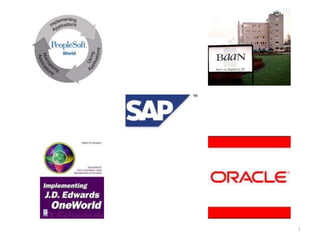
Session 1
- 1. 1
- 2. INTRODUCTION & EVOLUTION OF ERP Why Enterprise Resource Planning? Definition of ERP Systems Evolution of ERP Systems Concept of ERP Systems Advantages & Disadvantages of ERP Systems ERP Systems Architecture Modules of an ERP System 2
- 3. Why do I need to know ERP, today? Unprecedented growth of information & communication technology. Complex nature of today’s business environment Improve competitiveness by cost reduction and better logistics Right information at the right time brings timely rewards Business process are complex and mapping the functional processes has become vital 3
- 4. Definition of ERP Systems Enterprise resource planning systems or enterprise systems are software systems for business management, encompassing modules supporting functional areas such as planning, manufacturing, sales, marketing, distribution, accounting, financial, human resource management, project management, inventory management, service and maintenance, transportation and e-business. The architecture of the software facilitates transparent integration of modules, providing flow of information between all functions within the enterprise in a consistently visible manner. 4
- 5. American Production and Inventory Control Society (2001) has defined ERP systems as “a method for the effective planning and controlling of all the resources needed to take, make, ship and account for customer orders in a manufacturing, distribution or service company.” 5
- 7. Evolution of ERP Systems The evolution of ERP systems closely followed the spectacular developments in the field of computer hardware and software systems. During the 1960s most organizations designed, developed and implemented centralized computing systems, mostly automating their inventory control systems using inventory control packages (IC) such as COBOL, ALGOL and FORTRAN. Material requirements planning (MRP) systems were developed in the 1970s which involved mainly planning the product or parts requirements according to the master production schedule. Following this route new software systems called manufacturing resources planning (MRP II) were introduced in the 1980s with an emphasis on optimizing manufacturing processes by synchronizing the materials with production requirements. MRP II included areas such as shop floor and distribution management, project management, finance, human resource and engineering. 7
- 8. Evolution of ERP Systems, continued ERP systems first appeared in the late 1980s and the beginning of the 1990s with the power of enterprise-wide inter-functional coordination and integration. Based on the technological foundations of MRP and MRP II, ERP systems integrate business processes including manufacturing, distribution, accounting, financial, human resource management, project management, inventory management, service and maintenance, and transportation, providing accessibility, visibility and consistency across the enterprise. During the 1990s ERP vendors added more modules and functions as “add-ons” to the core modules giving birth to the “extended ERPs like APS, APO, CRM, SCM etc.” 8
- 9. The Concept of ERP 9
- 10. Characteristics of ERP Modular design comprising many distinct business modules such as financial, manufacturing, accounting, distribution, etc. Use centralized common database management system (DBMS) The modules are integrated and provide seamless data flow among the modules, increasing operational transparency through standard interfaces They are generally complex systems involving high cost They are flexible and offer best business practices They require time-consuming tailoring and configuration setups for integrating with the company’s business functions The modules work in real time with online and batch processing capabilities They are Internet-enabled (Web-enabled / Gui) 10
- 13. Architecture of ERP System The modules of an ERP system can either work as stand-alone units or several modules can be combined together to form an integrated system. The systems are usually designed to operate under several operating platforms such as UNIX, MS Windows NT, Windows 2000, IBM AIX, and HP-UX systems. Enterprise systems employ thin client/server (C/S) technology or client/fat server (C/FS) architecture, creating a decentralized computing environment. In a C/S system a number of client devices operated by end users such as desktop PCs request services from application servers, which in turn get the requested service-related information from the database servers. The requests may be simple data files, data values, communication services, transaction processing or master file updates. 13
- 14. Architecture of ERP System, continued The general practice is to have three-tier architecture In this three-tier system the user interface runs on the client. To run ERP systems relatively powerful PCs (clients) and powerful servers are required where most of the hundreds of thousands of operations are performed. The client/server system functions are performed following three layers of logic: Presentation Layer: Graphical user interface (GUI) or browser for data entry or accessing system functions Application Layer: Business rules, functions, logic, and programs acting on data received/transferred from/to the database servers Database Layer: Management of the organization’s operational or transactional data including metadata; mostly employs industry standard RDBMS with structured query language (SQL) provisions. 14
- 15. Three-tier ERP Systems Architecture 15
- 16. Modules of ERP – SAP R/3 Financial Accounting FI Controlling CO Asset Management AM Project System PS Workflow WF Industry Solutions IS Human Resources HR Plant Maintenance PM Quality Management QM Production Planning PP Materials Management MM Sales & Distribution SD Investment Management IM Enterprise Controlling EC Treasury TR 16
- 17. Modules of Internet Version mySAP.COM mySAP Workplace mySAP Supply Chain Management mySAP Customer Relationship Management mySAP Financials mySAP E-Procurement mySAP Product Lifecycle Mgmt. mySAP Business Intelligence mySAP Mobile Business mySAP Human Resources mySAP Marketplace by SAPMarkets mySAP Hosted Solutions mySAP Technology mySAP AllinOne Solutions for SMEs 17
